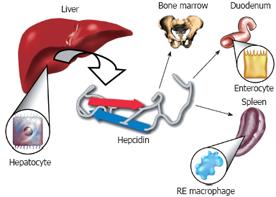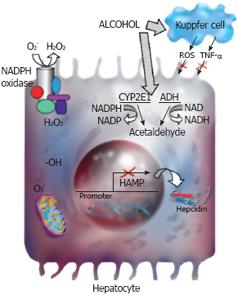Copyright
©2009 The WJG Press and Baishideng.
World J Gastroenterol. Mar 14, 2009; 15(10): 1186-1193
Published online Mar 14, 2009. doi: 10.3748/wjg.15.1186
Published online Mar 14, 2009. doi: 10.3748/wjg.15.1186
Figure 1 The Iron regulatory hormone hepcidin.
Hepcidin is synthesized in the hepatocytes of the liver as an 84 amino acid precursor protein. It is subsequently cleaved into the 25 amino acid biologically active peptide form and is released into the circulation. Hepcidin plays a central role in the regulation of iron metabolism by inhibiting the release of iron from the enterocytes of the duodenum and from reticuloendothelial macrophages. Hepcidin blocks the export of iron from these cells by binding to the iron exporter protein, ferroportin, which induces the internalization and degradation of ferroportin protein. As a soluble mediator, hepcidin establishes the cross-talk between distant organs in the body in order to maintain iron homeostasis.
Figure 2 Hepcidin and alcohol.
Alcohol is metabolized by alcohol dehydrogenase (ADH) and cytochrome P4502E1 (CYP2E1) in the liver. Alcohol-induced oxidative stress leads to the suppression of hepcidin promoter activity and hepcidin transcription in the liver. The parenchymal, but not the non-parenchymal cells of the liver are involved in the regulation of hepcidin transcription by alcohol-induced oxidative stress. The activation of CYP2E1 or NADPH oxidase and changes in mitochondrial functions are involved in alcohol-induced oxidative stress in hepatocytes. The role of these pathways in the regulation of hepcidin transcription by alcohol requires further investigation.
- Citation: Harrison-Findik DD. Is the iron regulatory hormone hepcidin a risk factor for alcoholic liver disease? World J Gastroenterol 2009; 15(10): 1186-1193
- URL: https://www.wjgnet.com/1007-9327/full/v15/i10/1186.htm
- DOI: https://dx.doi.org/10.3748/wjg.15.1186














